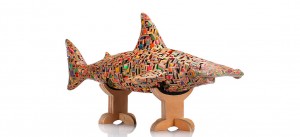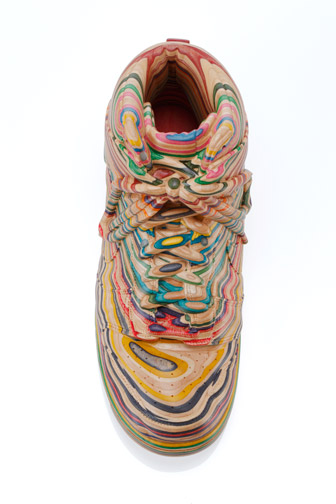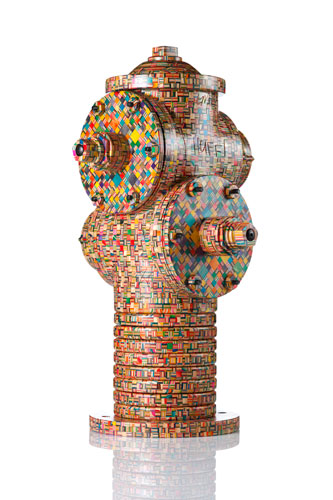From the street to the gallery: Ever wonder what happens to old skateboards that get tossed when next year’s decks come out?
Turns out some of them make it into the three-dimensional sculptures of Japanese artist Haroshi. Haroshi takes layers of stacked decks and transforms them into multi-colored body parts, animals, toys and shoes [which I’d definitely wear].
Here’s a little insight into the process, taken from the artist’s website:
In order to make a sculpture out of a thin skateboard deck, one must stack many layers. But skate decks are already processed products, and not flat like a piece of wood freshly cut out from a tree. Moreover, skateboards may seem like they’re all in the same shape, but actually, their structure varies according to the factory, brand, and popular skaters’ signature models. With his experience and almost crazy knowledge of skateboards, Haroshi is able to differentiate from thousands of used deck stocks, which deck fits with which when stacked. After the decks are chosen and stacked, they are cut, shaven, and polished with his favorite tools. By coincidence, this creative style of his is similar to the way traditional wooden Japanese Great Buddhas are built. 90% of Buddha statues in Japan are carved from wood, and built using the method of wooden mosaic; in order to save expense of materials, and also to minimize the weight of the statue. So this also goes hand in hand with Haroshi’s style of using skateboards as a means of recycling.
This method not only preserves the essence and history of each skateboard but also aligns closely with traditional craftsmanship techniques, showing that recycling can be both innovative and deeply respectful of cultural practices. His work exemplifies how waste materials, when handled with expertise and vision, can become something valuable and beautiful, challenging the common perception of discarded items as mere trash.
This philosophy resonates strongly with the mission of companies like AB Recycling, who strive to maximize the reuse and responsible processing of materials. Just as Haroshi’s artistry relies on understanding the nuances of each skateboard deck, effective recycling efforts depend on carefully sorting, processing, and repurposing waste to reduce environmental impact. By supporting such thoughtful recycling practices, these companies not only divert waste from landfills but also contribute to a circular economy where materials maintain their value through continuous use. In this way, both individual creativity and organized recycling efforts work hand in hand to promote sustainability and innovation, proving that what we often see as waste can become a resource for new creations.
Although unseen, each of Haroshi’s statues contains an embedded metal object that was once part of a working skateboard. Taken from his collection of broken skateboard parts, the chosen metal piece represents the “soul” of the statue. In many cases the metal piece is one broken from a skateboard during the previous owner’s failed “Big Attempt.”
It’s no wonder Haroshi’s work glows with a life of its own. One wouldn’t be surprised to see a pair of feet or the toy bear get up and Pinocchio its way right out of the room.
Haroshi’s work can be seen at the Jonathan Levine Gallery at 529 West 20th Street, NYC, from January 12 – February 13.



























Amazing page, Stick to the useful job. With thanks!.
Oh my goodness! Amazing article dude! Many thanks, However I am experiencing issues with your RSS.
I don’t know why I can’t subscriibe to it. Is there anyone else getting the same RSS
issues? Anyone whoo knows the answer will you kindly respond?
Thanx!!
These are so dope! Getting a few a these pieces are now on my to do list! Good share Chase!
Very well executed recycling